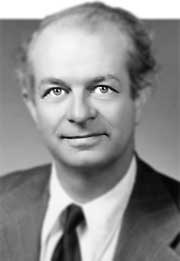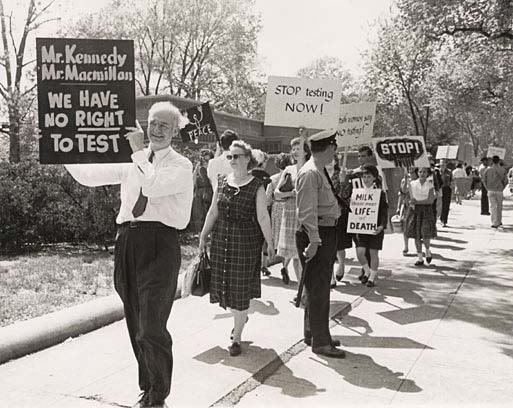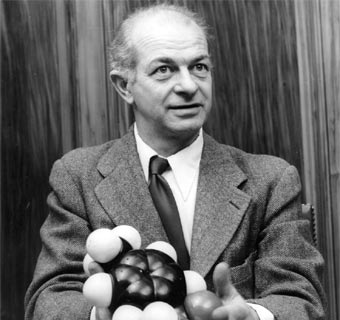La grandeza de los hombres que piensan en sus semejantes.

Linus Pauling
Nació el 28 de febrero de 1901 en la ciudad de Portland, Estado de Oregón, en EE.UU. Cursó estudios en la universidad estatal de Oregón y en el Instituto Tecnológico de California. Hijo del farmacéutico Herman Henry William Pauling. Durante los años 1919-1920, Pauling colaboró como Profesor full time de Análisis Cuantitativo en el State College. After which he was appointed a Teaching Fellow in Chemistry in the California Institute of Technology and was a graduate student there from 1922 to 1925, working under Professor Roscoe G. Dickinson and Richard C. Tolman. In 1925 he was awarded the Ph.D. (summa cum laude) in chemistry, with minors in physics and mathematics..Obtuvo el Título de Grado en Ingeniería Química, en 1922, y luego el Doctorado en Química y Física en 1925. Fue Profesor de química en Oregón, en donde realizó muchos de sus descubrimientos desde 1927 hasta 1964.

Por medio de la invención de técnicas como las de los rayos X y la difracción del electrón, pudo calcular las distancias interatómicas y los ángulos entre los enlaces químicos. La naturaleza del enlace químico, obra que escribió como resultado de estas investigaciones, ha sido de una influencia fundamental en el pensamiento científico desde su publicación en 1939. A finales de los años 50, promovió el consumo de grandes cantidades de vitamina C al día, al menos de uno a dos gramos diarios.
Investigó la estructura atómica de las proteínas y descubrió que la deformidad de las células en la anemia falciforme, se produce por un defecto genético que influye en la producción de hemoglobina. Recibió en 1954 el Premio Nobel de Química por este importantisimo trabajo.
En los años siguientes, Pauling se preocupó y se transformó en un encendido activista por la paz, un firme opositor a las pruebas nucleares, presentando un destacado escrito sobre el tema en las Naciones Unidas, en 1958, firmado por más de 11.000 científicos. En 1962, debido a su destacada lucha pacifista, recibió el Premio Nobel de la Paz, siendo la única persona en recibir dos veces el Premio Nobel en forma individual y la segunda persona (con Marie Curie) que recibía dos premios Nobel en la historia.


En 1973 fundó con dos colegas el Instituto de Medicina Ortomolecular de Meulon Park, en Oregon. El nombre del instituto luego cambió a Instituto Linus Pauling de Ciencia y Medicina.
Pauling falleció el 19 de agosto de 1994 en Big Sur, California. Luego de su muerte, al llegar el año1996, el Instituto fue trasladado a Corvallis, para situarse definitivamente como parte de la Universidad Estatal de Oregón.
Rinus Pauling está considerado para algunos como uno de los veinte científicos más brillantes de todos los tiempos y, junto a Albert Einstein, son las dos personalidades del Siglo XX que allí se ubican.

Datos: http://www.buscabiografias.com/biografia/verDetalle/4346/Linus%20Pauling

Video de YouTube
Biography
Linus Carl Pauling
Was born in Portland, Oregon, on 28th February, 1901, the son of a druggist, Herman Henry William Pauling, who, though born in Missouri, was of German descent, and his wife, Lucy Isabelle Darling, born in Oregon of English-Scottish ancestry.
Linus attended the public elementary and high schools in the town of Condon and the city of Portland, Oregon, and entered the Oregon State College in 1917, receiving the degree of B.Sc. in chemical engineering in 1922. During the years 1919-1920 he served as a full-time teacher of quantitative analysis in the State College, after which he was appointed a Teaching Fellow in Chemistry in the California Institute of Technology and was a graduate student there from 1922 to 1925, working under Professor Roscoe G. Dickinson and Richard C. Tolman. In 1925 he was awarded the Ph.D. (summa cum laude) in chemistry, with minors in physics and mathematics.
Since 1919 his interest lay in the field of molecular structure and the nature of the chemical bond, inspired by papers by Irving Langmuir on the application of the Lewis theory of the sharing of pairs of electrons between atoms to many substances. In 1921 he suggested, and attempted to carry out, an experiment on the orientation of iron atoms by a magnetic field,
through the electrolytic deposition of a layer of iron in a strong magnetic field and the determination of the orientation of the iron crystallises by polishing and etching the deposit, and microscopic examination of the etch figures. With Professor Dickinson, he began in 1922 the experimental determination of the structures of some crystals, and also started theoretical work on the nature of the chemical bond.
Since his appointment to the Staff of California Institute of Technology, Professor Pauling was elected Research Associate in 1925; National Research Fellow in Chemistry, 1925-1926; Fellow of the John Simon Guggenheim Memorial Foundation, 1926-1927 (through this last he worked in European Universities with Sommerfeld, Schrödinger, and Bohr); Assistant Professor of Chemistry, 1927-1929; Associate Professor, 1929-1931; Professor, 1931, when he was the first recipient of the American Chemical Society Award in Pure Chemistry - the Langmuir Prize - and Chairman of the Division of Chemistry and Chemical Engineering, and Director of the Gates and Crellin laboratories of Chemistry, 1936-1958. In 1963, he was awarded the Nobel Peace Prize.
Pauling is a member of numerous professional societies in the U.S.A. as well as in many European countries, India, Japan and Chile. Awards, medals, and honorary degrees were showered upon him in America and Europe, and in addition he was elected Rationalist of the Year for 1960 and Humanist of the Year for 1961. Several books have come from his pen, ranging from his most famous one The Nature of the Chemical Bond, and the Structure of Molecules and Crystals (1939, 1949, 1960) via General Chemistry (1947, 1953), which was translated into nine languages, to No More War! (1958, 1959,1962).
The subjects of the papers he published reflect his great scientific versatility: about 350 publications in the fields of experimental determination of the structure of crystals by the diffraction of X-rays and the interpretation of these structures in terms of the radii and other properties of atoms; the application of quantum mechanics to physical and chemical problems, including dielectric constants, X-ray doublets, momentum distribution of electrons in atoms, rotational motion of molecules in crystals, Van der Waals forces, etc.; the structure of metals and intermetallic compounds, the theory of ferromagnetism; the nature of the chemical bond, including the resonance phenomenon in chemistry; the experimental determination of the structure of gas molecules by the diffraction of electrons; the structure of proteins; the structure of antibodies and the nature of serological reactions; the structure and properties of hemoglobin and related substances; abnormal hemoglobin molecules in relation to the hereditary hemolytic anemias; the molecular theory of general anesthesia; an instrument for determining the partial pressure of oxygen in a gas; and other subjects.
Pauling married Ava Helen Miller of Beaver Creek, Oregon, in 1923. She is of English-Scottish and German descent. They have four children, Linus (Carl) Jr. (1925), Peter Jeffress (1931), Linda Helen (1932) and Edward Crellin (1937), and thirteen grandchildren.
Since his appointment to the Staff of California Institute of Technology, Professor Pauling was elected Research Associate in 1925; National Research Fellow in Chemistry, 1925-1926; Fellow of the John Simon Guggenheim Memorial Foundation, 1926-1927 (through this last he worked in European Universities with Sommerfeld, Schrödinger, and Bohr); Assistant Professor of Chemistry, 1927-1929; Associate Professor, 1929-1931; Professor, 1931, when he was the first recipient of the American Chemical Society Award in Pure Chemistry - the Langmuir Prize - and Chairman of the Division of Chemistry and Chemical Engineering, and Director of the Gates and Crellin laboratories of Chemistry, 1936-1958. In 1963, he was awarded the Nobel Peace Prize.
Pauling is a member of numerous professional societies in the U.S.A. as well as in many European countries, India, Japan and Chile. Awards, medals, and honorary degrees were showered upon him in America and Europe, and in addition he was elected Rationalist of the Year for 1960 and Humanist of the Year for 1961. Several books have come from his pen, ranging from his most famous one The Nature of the Chemical Bond, and the Structure of Molecules and Crystals (1939, 1949, 1960) via General Chemistry (1947, 1953), which was translated into nine languages, to No More War! (1958, 1959,1962).
The subjects of the papers he published reflect his great scientific versatility: about 350 publications in the fields of experimental determination of the structure of crystals by the diffraction of X-rays and the interpretation of these structures in terms of the radii and other properties of atoms; the application of quantum mechanics to physical and chemical problems, including dielectric constants, X-ray doublets, momentum distribution of electrons in atoms, rotational motion of molecules in crystals, Van der Waals forces, etc.; the structure of metals and intermetallic compounds, the theory of ferromagnetism; the nature of the chemical bond, including the resonance phenomenon in chemistry; the experimental determination of the structure of gas molecules by the diffraction of electrons; the structure of proteins; the structure of antibodies and the nature of serological reactions; the structure and properties of hemoglobin and related substances; abnormal hemoglobin molecules in relation to the hereditary hemolytic anemias; the molecular theory of general anesthesia; an instrument for determining the partial pressure of oxygen in a gas; and other subjects.
Pauling married Ava Helen Miller of Beaver Creek, Oregon, in 1923. She is of English-Scottish and German descent. They have four children, Linus (Carl) Jr. (1925), Peter Jeffress (1931), Linda Helen (1932) and Edward Crellin (1937), and thirteen grandchildren.
From Nobel Lectures, Chemistry 1942-1962, Elsevier Publishing Company, Amsterdam, 1964
This autobiography/biography was written at the time of the award and first published in the book series Les Prix Nobel. It was later edited and republished in Nobel Lectures. To cite this document, always state the source as shown above. Linus Pauling died on August 19, 1994.
Copyright © The Nobel Foundation 1954Fuente: http://www.nobelprize.org/nobel_prizes/chemistry/laureates/1954/pauling-bio.html
No hay comentarios:
Publicar un comentario
Su comentario es muy importante. Gracias.
Your comment is very important. Thank you.